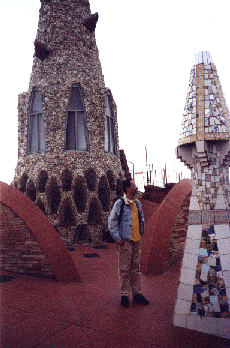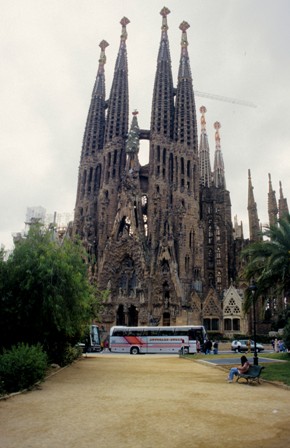
Barcelona
part 1
Wednesday 16 April 1997
Our departure for Barcelona is less than hassle free, as our flight turns out to be overbooked. In the end in turns out quite well: we get seats in Business Class. Very comfy. At Barcelona airport (El Prat de Llobregat) we take the Cercanías train (regional railway) to the city centre. Our Hotel, Gaudí, is just off the Ramblas, the long popular boulevard bisecting the old centre of the city. After having settled in in our room we go for a bite and a drink on Plaza Real in the Barri Gotíc, the old part of town East of the Ramblas. It is a bit of an odd square. In architecture it resembles similar squares in Madrid and Salamanca, but the atmosphere is somewhat ambivalent. Last time I was here (1986) it was still home to tramps and prostitutes. That has changed, but the has not quite got there were it should be. We start a walk throught the Barri Gotíc and visit, among others, the cathedral (La Seu), one of the largest gothic structures in Spain. It takes a central position on the location where a Roman temple and a moorish mosque once stood. It was finished in 1448. Beautiful altar pieces, especially in the various chapels. It bit further on on the Plaça del Rei is another group of historically interesting buildings. One is the Saló de Tinell from the 14th century, where once the inquistion resided. On the steps in front of the palace king Ferdinand and queen Isabella welcomed Columbus when he returned from his discovery of the Americas. We wander through the many narrow and winding streets and alleys of the old quarter. A nice square is the Placeta del Pi with the church and bar of the same name. We have a drink in the café El Quatre Gats. The bar dates from 1897 and was founded by a group of modernist artist. The café is beautifully decorated. The café was once the centre of modernist art. Picasso held his firs exhibition here in 1901.
Early evening we have tapas (snacks) on the square near the cathedral before we have dinner at "Egipte" a popular and inexpensive restaurant in the Barri Xines quarter, West of the Ramblas.
Later we look for some entertainment in the gay scene of Barcelona. First we stop at the quiet Café de la Calle in Gracía, a neighbourhood North of the centre, later we try the trendy Punto BCN in the fashionable Eixample district.
Thursday 17 April 1997
Today is our Antoní Gaudí day. The modernist architect with his
idiosyncratic style.
 We start at the Palau Güell, built in 1885 for the shipowner and
industrialist Eusebio Güell. The building is, in contrast with most of
Gaudí's designs, open to visitors. The building's interior is as interesting as
its facade. Gaudí's playful forms and decorations are inimitable. Even the roof
top is decorated with fanciful ventilation shafts and chimneys. We follow
the Ramblas up to the Plaça de Catalunya and continue towards the Casa Calvet
from 1899. This is Gaudi's first apartment building and rather conventional. The
ground floor now houses a (pricey) restaurant. We head for the Passeig de
Gracia op, the fashionable shopping street of Barcelona. Here are all the trendy
fashion stores. But also the so called "Manzana de la Discórdia"
(Block of discord) a row of three modernist buildings with completely
conflicting styles. The first is Casa Lleó Morera by Domènech de Montaner, the
least spectacular. Then comes Casa Amatller, a lot more conspicuo
We start at the Palau Güell, built in 1885 for the shipowner and
industrialist Eusebio Güell. The building is, in contrast with most of
Gaudí's designs, open to visitors. The building's interior is as interesting as
its facade. Gaudí's playful forms and decorations are inimitable. Even the roof
top is decorated with fanciful ventilation shafts and chimneys. We follow
the Ramblas up to the Plaça de Catalunya and continue towards the Casa Calvet
from 1899. This is Gaudi's first apartment building and rather conventional. The
ground floor now houses a (pricey) restaurant. We head for the Passeig de
Gracia op, the fashionable shopping street of Barcelona. Here are all the trendy
fashion stores. But also the so called "Manzana de la Discórdia"
(Block of discord) a row of three modernist buildings with completely
conflicting styles. The first is Casa Lleó Morera by Domènech de Montaner, the
least spectacular. Then comes Casa Amatller, a lot more conspicuo us,
built in 1900 by Puig i Cadafalch for a chocolate manufacturer of that name. It
has lots of tile decorations and sculptures in its facade. The most extreme of
the three is Casa Battló by Gaudi (1907). Gaudí was commisioned to give the an
existing building a bit of a face lift and that is what he did. Further on
the street is an apartment complex by Gaudí, the Casa Mila aptly dubbed La
Pedrera (the stone quarry). It is rather gloomy and is located on a corner. The
top floor is a museum dedicated to the architect. The roof is open to visitors
too and a sight in its own right. After Casa Mila we look at some buildings by
Gaudí's comtemporaries in the neighbourhood (Casa Vinçons, Casa Fuster) before
we take the metro to the Sagrada Familia, the unfinished masterpiece of
Gaudi. This cathedral does not ever seem to get finished. During its
construction Gaudí was killed in a traffic accident. During the civil war the
anarchists destroyed all the building plans and sketches after which
construction was stopped. In 1968 construction was resumed intermittently
according to new plans, which were not all received very well by critics.
A couple of the twelve spires can be climbed.
us,
built in 1900 by Puig i Cadafalch for a chocolate manufacturer of that name. It
has lots of tile decorations and sculptures in its facade. The most extreme of
the three is Casa Battló by Gaudi (1907). Gaudí was commisioned to give the an
existing building a bit of a face lift and that is what he did. Further on
the street is an apartment complex by Gaudí, the Casa Mila aptly dubbed La
Pedrera (the stone quarry). It is rather gloomy and is located on a corner. The
top floor is a museum dedicated to the architect. The roof is open to visitors
too and a sight in its own right. After Casa Mila we look at some buildings by
Gaudí's comtemporaries in the neighbourhood (Casa Vinçons, Casa Fuster) before
we take the metro to the Sagrada Familia, the unfinished masterpiece of
Gaudi. This cathedral does not ever seem to get finished. During its
construction Gaudí was killed in a traffic accident. During the civil war the
anarchists destroyed all the building plans and sketches after which
construction was stopped. In 1968 construction was resumed intermittently
according to new plans, which were not all received very well by critics.
A couple of the twelve spires can be climbed.
At night we eat in the Gracía district in a mexican restaurant, Cantina
Mexic ana,
after which we visit some gay bars in the neighbourhood.
ana,
after which we visit some gay bars in the neighbourhood.
Friday 18 April 1997
After a good coffee at Café Opera on the Ramblas, we walk to the
Ciutadela quarter, East of the Barri Gótic. The main attraction here, is the
Picasso Museum, where we spend a couple of hours for the interesting collection.
It is housed in a medieval city palace on a narrow street. The museum does not
own the artist's most famous pieces and nothing is cubist, but does give you a
good impression of Picasso's development as an artist from his early work to his
master pieces. After the museum we spend some time in the Parque de Ciutadella.
The large park on the North East side of town. It was once the location for a
fortress, but in the 19th century it became a park. In 1888 it was the location
for that year's ex po.
We walk in the general direction of the sea and then follow the boulevard
towards the Barceloneta, originally a fisherman's quarter. From here we
take the cable car tot the Montjuic, the mountain dominating the city on the
Southwest side of town. Up there we walk on to the Olympic Stadium. The stadium
was originally not intended for the 1992 games, but for the international fair
of 1929. In 1936 the Peoples Games would have been held here as an
alternative to the Olympic Games of Berlin, that were being abused for Nazi
propaganda. However, when the athletes arrive in Barcelona the Civil war broke
out a day before the games were due to start. The games were
cancelled and a number of athletes and supporters stayed on to join the
republican forces in the fight against general Franco.
po.
We walk in the general direction of the sea and then follow the boulevard
towards the Barceloneta, originally a fisherman's quarter. From here we
take the cable car tot the Montjuic, the mountain dominating the city on the
Southwest side of town. Up there we walk on to the Olympic Stadium. The stadium
was originally not intended for the 1992 games, but for the international fair
of 1929. In 1936 the Peoples Games would have been held here as an
alternative to the Olympic Games of Berlin, that were being abused for Nazi
propaganda. However, when the athletes arrive in Barcelona the Civil war broke
out a day before the games were due to start. The games were
cancelled and a number of athletes and supporters stayed on to join the
republican forces in the fight against general Franco.
At night we eat in a gay restaurant, Casanova. Very trendy, including a drag show, with reasonable food.